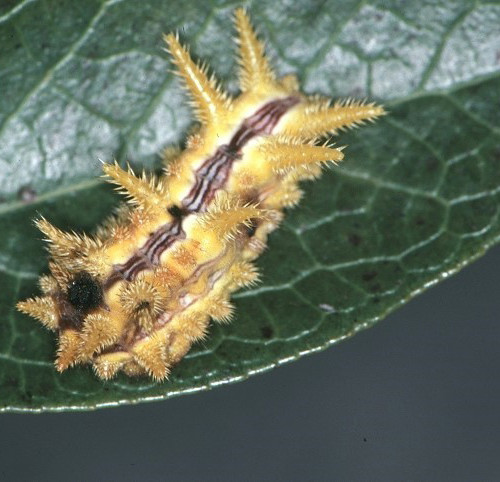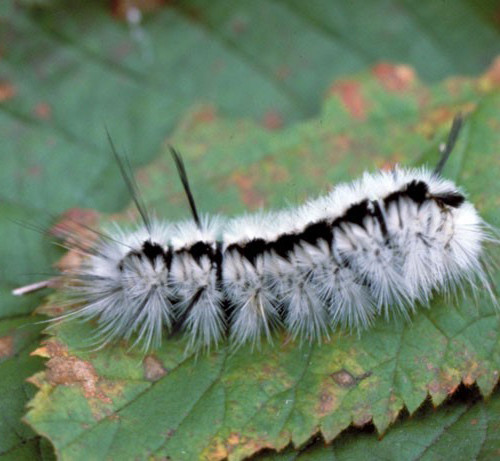 Written by Susan Himes, Susan.Himes@ag.tamu.edu
Written by Susan Himes, Susan.Himes@ag.tamu.edu
AgriLife experts warn stinging caterpillars can cause contact rashes, painful reactions
As the weather warms up and people begin spending more time in their yards, parks and forests, more people will be coming home with a rash or bug bite.
However, Texas A&M AgriLife Extension Service experts say before you blame a flying insect or a poisonous plant for a skin ailment, you may need to consider another culprit – stinging caterpillars.
“Spring foliage has brought on an abundance of caterpillars, a few of whom carry irritating or even venomous hairs,” said Janet Hurley, AgriLife Extension integrated pest management for schools statewide specialist, Dallas.
“We normally have fact sheets available for schools this time of year, but with most children out of school due to COVID-19, we wanted to make sure parents are aware that there are stinging caterpillars in Texas, what they look like, and how to avoid them,” she said.
Stinging caterpillar species include the buck moth caterpillar, spiny oak slug caterpillar, hickory tussock moth caterpillar, saddleback caterpillar and Io moth caterpillar.
Perhaps the most painful caterpillar in Texas is the southern flannel moth caterpillar, also known as the asp or puss caterpillar. An encounter with a puss caterpillar is very painful and may even require a trip to the hospital, according to AgriLife Extension experts.
What stinging caterpillars look like
Hurley said she recently received her first tussock moth caterpillar question – confirming that just about every species of stinging caterpillar has now been spotted in our state.
“A good rule of thumb is if a caterpillar looks ‘fuzzy’ — don’t touch it,” said Molly Keck, AgriLife Extension specialist in integrated pest management and entomologist, Bexar County.
Although many fuzzy caterpillars are not dangerous, do not pick up a caterpillar unless you are sure it is not of the stinging variety. The puss caterpillar, for example, looks deceptively soft and can be especially tempting for children to want to pick up or “pet.”
“These teardrop shaped caterpillars look touchable, but they are not,” emphasized Wizzie Brown, AgriLife Extension specialist in integrated pest management for Travis County. “Asps have spines attached to venom glands that can lead to a nasty sting, rash and other issues.”
Caterpillar sting symptoms and treatment
“Since these caterpillars tend to hide, you may not even know you’ve encountered one until you feel the sting,” Hurley said.
If you are stung, you may feel immediate pain and reddish colored spots may appear where spines entered the skin. Some people may not feel pain until several minutes after they are stung, while others can experience intense throbbing or radiating pain. Other people may not feel much discomfort, and a red rash may be the only telltale sign.
Brown said different people respond to caterpillar toxin differently. “Some people may have a more severe reaction than others, and where on your body you are stung and the thickness of that skin can affect your reaction too.”
If the caterpillar is still on you, immediately brush it off if possible and then use tape to remove the spines that may still be in your skin, Brown said.
Washing the area with soap and water and applying an ice pack to the sting may offer some relief, and an oral antihistamine may help to relieve itching. Over-the-counter insect sting and bite relief products can also help.
“The pain often goes away within an hour,” said Mike Merchant, Ph.D., AgriLife Extension urban entomologist, Dallas.
Other symptoms after a sting can include nausea, vomiting, headaches, respiratory stress or shock. Since reactions to the toxins from stinging caterpillars can vary, seek medical advice or treatment immediately or go to an emergency room if you are concerned. Merchant also stressed that any contact with eyes or an allergic reaction to a sting requires immediate medical attention.
Stinging caterpillar habitat
“You are more likely to encounter stinging caterpillars when they leave their host plant in search of a spot to pupate, which is currently happening with many caterpillars,” said Keck. “They aren’t aggressive and won’t come after you, but they can drop from trees.”
Keck has reported sightings of both buck moth caterpillars and tussock moth caterpillars in the Bexar County area already this spring. Texans statewide need to be on the alert and keep an eye on trees and shrubs for caterpillar development, which typically occurs now into the fall.
Some common tree hosts are apple, basswood, cherry, dogwood, elm, maple, plum and oak, which is a favorite of the buck moth caterpillar. Some stinging caterpillars may even be found on crops such as corn.
“Adult puss moths emerge in late spring or early summer to lay several hundred eggs on favored host trees,” said Merchant. “Caterpillars may also be seen feeding on dwarf yaupon and other shrubs. One to two generations occur each year, though southern flannel moth caterpillars tend to be more common in the fall.”
Pest management
Avoid stinging caterpillars by not sitting under trees and wearing long sleeves and pants outdoors, although even that is no guarantee of protection.
“I had the misfortune of getting an eastern buck moth caterpillar on my pants the other day and accidentally brought it inside,” said Keck. “When I rested my hand on my leg, I encountered the hairs/barbs and it didn’t feel good. It itched and left an uncomfortable feeling on my thumb for a couple hours.”
Keck said there isn’t much you can do about managing these caterpillars until they all pupate and go away. You don’t need to worry about harm to your garden however, as stinging caterpillars typically do not do enough feeding to harm plants.
If you have large populations of stinging caterpillars and decide you need to try to manage them, you can try Bacillus thuringiensisvar. kurstaki, BTK. However, this will also kill all the non-stinging or “good” caterpillars, which are an important food source for songbirds. You may also look for a pesticide with active ingredients such as spinosad or azadirachtin, which are naturally derived products.
Merchant said puss moth caterpillars can also be controlled when they become abundant by spraying with a residual pesticide such as permethrin, cyfluthrin or similar sprays labeled for control of caterpillars on ornamental plants.
“The best solution to dealing with stinging caterpillars may just be educating adults and children on what these caterpillars are, what they look like, and the importance of not touching them with bare hands,” concluded Merchant.













